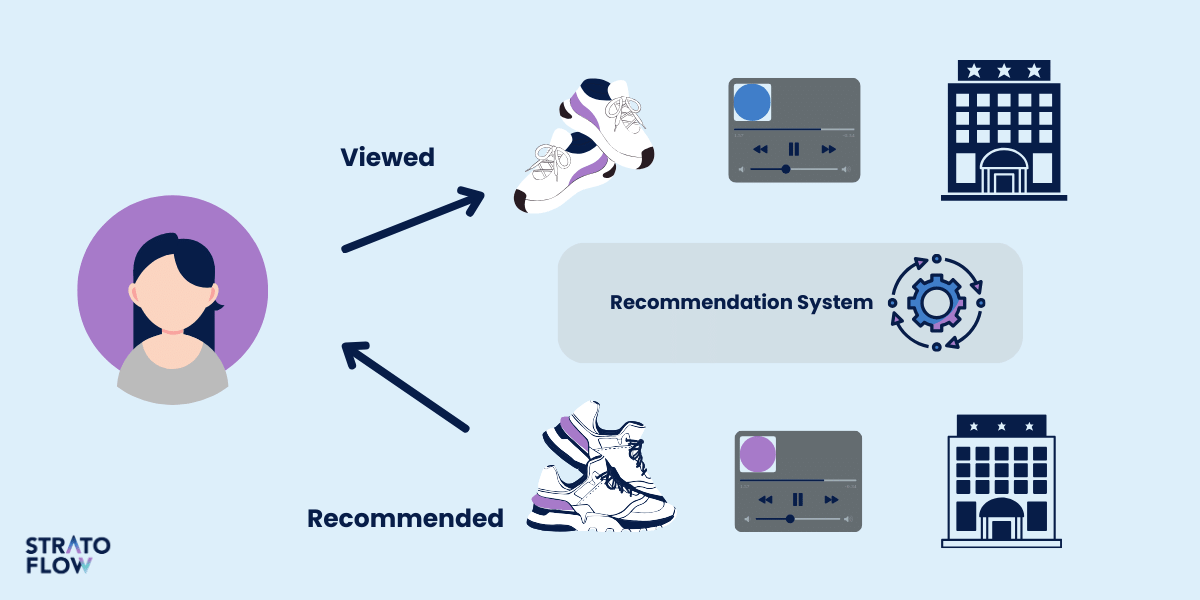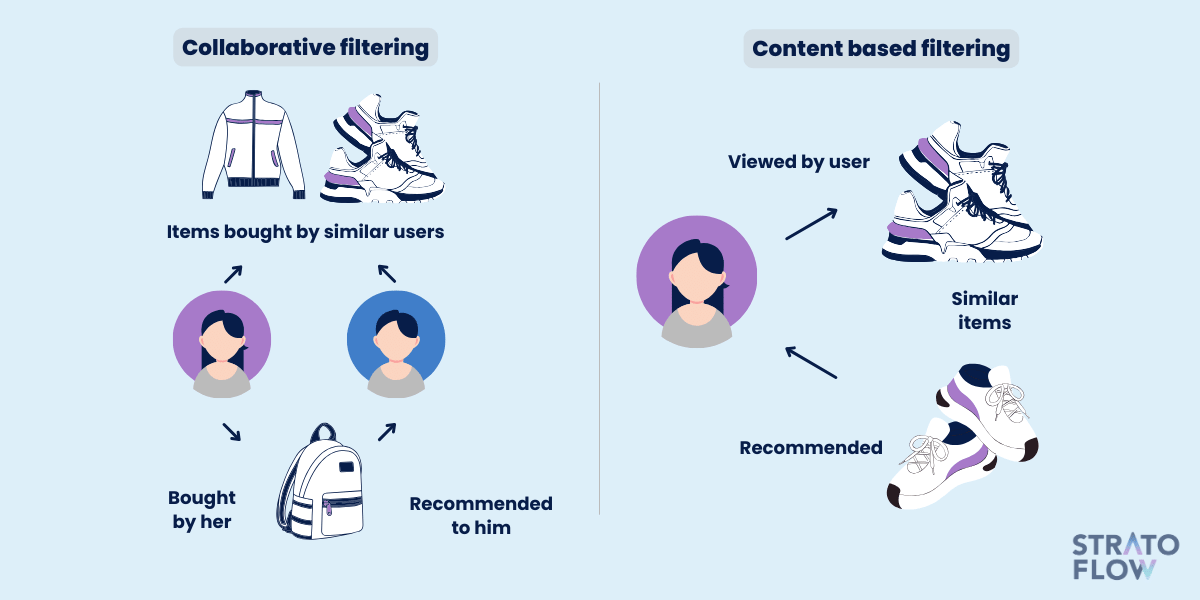
Spotify Recommendation Algorithm: What’s The Secret to Its Success?
Since 2016, Spotify’s Discover Weekly playlist has been capturing the interest of millions with its spot-on song selection.
The secret to this success lies in Spotify’s sophisticated recommendation algorithm, which combines collaborative filtering, content-based filtering and advanced audio analysis.
By seamlessly integrating these technologies, Spotify not only enhances the user experience, but also sets a high standard for personalization across industries.
In this article, we’ll take a closer look at how Spotify’s algorithm works and explore its broader implications for other industries.
Contents
- Content Recommendation Engines: New Way of Music Discovery
- Harnessing Data: Spotify’s Secret to Accurate Music Recommendations
- How it All Started: Beginnings of Spotify’s Recommendation System
- How Spotify’s Recommendation System Works?
- Importance of Personalization For Other Industries
- Value of Personalization for Media Industry
Content Recommendation Engines: New Way of Music Discovery
In recent years, recommendation engines have become the backbone of media streaming platforms, revolutionizing the way we discover and consume content online.
These sophisticated algorithms sift through vast amounts of data to predict user preferences and suggest personalized content, making each user’s experience unique and engaging.
This technology is particularly evident in the case of Spotify – one of the world’s leading music streaming platforms.
Spotify’s recommendation engine is a complex software system that integrates several advanced data filtering techniques, natural language processing, and deep learning.
By analyzing user behavior, such as listening history, preferences, and even skips, Spotify creates a highly personalized music experience. With each interaction, the system learns more about the user’s tastes, allowing it to make increasingly accurate and enjoyable recommendations.
The role of Spotify’s recommendation system is more significant than you might initially assume.
Not only does it increase user satisfaction by effortlessly introducing listeners to new tracks and artists they are likely to enjoy, it also supports the discovery of niche genres and up-and-coming musicians.
This dynamic interaction between users and the recommendation engine fosters a vibrant music ecosystem where both well-known and obscure artists can thrive, and the company itself can improve its user engagement metrics in the process – a win-win situation for everyone involved.

Harnessing Data: Spotify’s Secret to Accurate Music Recommendations
Let’s start with the foundation of any solid recommendation system: data.
What’s the Spotify approach to data gathering?
It all starts with a user’s first interaction with the service.
Every user, whether using the mobile application or the PC version, is required to create an account and log in before using the music streaming services.
This allows you to accurately track each user’s browsing history and later analyze that data, look for correlations between different songs and music genres, and compare the user’s preferences to the entire user database.
Other websites and e-commerce stores use cookies to collect behavioral information for this purpose.
In this respect, the Spotify solution has the advantage of having constant access to each user’s history without the risk of deleting cookies.
Quantifying Music Characteristics: Metrics That Differentiate Songs from Each Other
Spotify’s recommendation system is distinguished by its sophisticated use of audio analytics to dissect and understand the vast amount of data embedded in each track.
Sound crazy?
Spotify uses advanced natural language processing techniques to analyze song lyrics and metadata during listening sessions, expanding its understanding of music beyond just audio characteristics.
Here are twelve examples of metrics Spotify uses to differentiate songs:
- Danceability: Quantifies a song’s dance-worthy quality, providing insights into its rhythmic patterns and groove. A higher score indicates a track that is likely to make you move and groove.
- Loudness: Measures a song’s auditory intensity or volume, helping to categorize songs based on their dynamic range, from soft and mellow to energetic and intense.
- Energy: Reflects the intensity and vigor of a track, assessing how active and powerful the music feels. This metric is valuable for determining a song’s overall mood.
- Valence: Gauges a song’s emotional tone, ranging from negative to positive. This provides insights into the song’s overall positivity or melancholy.
- Tempo: Represents the speed of a song’s rhythm, measured in beats per minute (BPM). It categorizes songs into different pace categories, from slow ballads to up-tempo dance tracks.
- Acousticness: Quantifies the presence of acoustic instruments in a song, helping to distinguish between tracks with more organic sounds and those heavily reliant on electronic elements.
- Instrumentalness: Measures the extent to which a track contains vocals. A high score suggests a primarily instrumental composition.
- Speechiness: Identifies the presence of spoken words or vocal elements in a song, helping to distinguish between more instrumental tracks and those that feature vocal content.
- Key: Indicates the tonal center of a song, helping to classify tracks based on their musical key signatures.
- Mode: Identifies whether a track is in a major or minor key, contributing to the song’s emotional tone and mood.
- Time Signature: Defines the rhythmic structure of a song, indicating the number of beats in each measure and influencing the song’s overall feel.
- Duration: Represents the length of a song in minutes and seconds, providing basic information about the track’s playtime.
And it doesn’t stop there, because the data extracted from the songs themselves is just the tip of the iceberg.
Let’s take a step back and look at the history of the system itself before we dive into its inner workings.
How it All Started: Beginnings of Spotify’s Recommendation System
In 2014, Spotify took a major step forward by acquiring The Echo Nest, a music analytics company.
This move was critical to Spotify’s efforts to improve its recommendation system.
The Echo Nest brought expertise in machine learning and natural language processing, which allowed for sophisticated analysis of songs, artists, and user behavior.
Prior to acquiring The Echo Nest, Spotify’s algorithm relied primarily on collaborative filtering techniques. While effective to a point, this method was limited in its ability to understand the deeper nuances of music and user preferences.
By integrating these advanced technologies, Spotify was able to significantly improve the accuracy and personalization of its music recommendations.
This acquisition not only helped Spotify refine its recommendation algorithms, but also provided users with a more engaging and personalized music discovery experience.
How Spotify’s Recommendation System Works?
Building on the foundation established with the acquisition of The Echo Nest, Spotify has developed a complex framework that combines multiple methods to accurately understand and predict user preferences.
In the following paragraphs, we will explore the key components of this system, focusing on how Spotify uses various data methods to generate recommendations and present them in smart playlists.
These techniques, along with continuous learning and real-time data processing, enable Spotify to deliver music suggestions that resonate deeply with individual users and enhance their overall listening experience.
Data Filtering Methods
Spotify doesn’t use a single revolutionary recommendation model to generate all of its personalized playlists.
Spotify’s recommendation system combines some of the best strategies from different types of models to create a powerful and comprehensive solution.
To create the Discover Weekly playlists, the platform uses 3 very important elements of AI recommendation engines:
Collaborative Filtering Model
Collaborative filtering is a core component of Spotify’s recommendation system and plays a critical role in personalizing the music experience for each user.
It works by analyzing the listening behavior of millions of users and identifying patterns and similarities. Essentially, it uses the collective tastes and preferences of Spotify’s vast user base to make predictions about what individual users might enjoy.
Spotify analyzes a user’s listening history to recommend songs by finding users with similar listening habits and suggesting tracks that those similar users have enjoyed.

Two key aspects of collaborative filtering in Spotify’s system are:
- Musical Maps to Navigate the Complex World of Music Genres: Music maps are visual representations of how songs are related based on user listening patterns. Spotify creates these maps by analyzing which tracks are often played together and grouping songs into clusters that reflect common listening patterns. This clustering helps Spotify identify relationships between different tracks and genres, making it easier to recommend songs that match a user’s tastes. For example, if a significant number of users enjoy the same songs and also frequently listen to another song, those songs will be clustered together. This allows Spotify to suggest songs that are not only in the same genre, but also share listening contexts, enhancing the music streaming experience.
- Proximity Reflects Musical Similarity: The proximity of tracks on the map is not random; it’s a visual representation of how similar tracks are based on user behavior. If two songs are often listened to back-to-back, they’ll be adjacent stars on the map. This proximity indicates that users who like one song might also like the other. It’s like discovering a new favorite song through the musical constellations formed by the preferences of others.
Content-Based Filtering Model
While collaborative filtering is a powerful tool, it faces challenges during special occasions.
For example, Mariah Carey’s “All I Want for Christmas Is You” may often be paired with holiday songs due to proximity-based recommendations.
But that doesn’t always match individual preferences.
To address this, Spotify introduced content-based filtering.
By addressing the limitations of proximity-based suggestions and incorporating content-based filtering, Spotify’s recommendation system creates a dynamic interplay of insights.
Content-based filtering adds depth to recommendations by analyzing more than just listening patterns. It delves into the attributes of each track to capture its essence.
Spotify’s algorithm extracts metadata, performs raw audio analysis, and even considers cultural context. For example, metrics like danceability and loudness help understand a track’s sonic characteristics, while lyrics and adjectives from articles provide cultural insights.
As a result, Spotify can recommend songs that have similar characteristics to those a user already enjoys, even if those songs are not commonly paired together by other users.

Here are some of the key factors Spotify considers:
- Release Date: The official launch date of a song, providing context about its era and historical backdrop.
- Label: The record label associated with a track, offering insights into the artist’s affiliations and musical style.
- Artist: The creator of the track, significantly influencing its genre, sound, and storytelling.
- Album: The collection of songs the track belongs to, contributing to its broader thematic context.
- Genre: The musical category of the track, indicating its general style and sonic characteristics.
- Duration: The length of the track, affecting its structure and how it engages listeners.
- Key Signature: The tonal center of the track, which shapes its mood and emotional impact.
- Mode: Whether the track is in a major or minor key, influencing its overall feel and atmosphere.
- Time Signature: The rhythmic framework of the track, which determines its beat and groove.
- Tempo: The speed of the track’s rhythm, measured in beats per minute (BPM), impacting its energy level.
- Language: The language in which the track’s lyrics are sung, catering to linguistic preferences and cultural context.
- Instruments: The instruments used in the track’s composition, shaping its overall sound and texture.
- Featured Artists: Additional artists who contribute to the track, adding diversity to its musical elements.
- Producer: The individual overseeing the track’s production, playing a crucial role in its sound quality and arrangement.
- Lyrics: The words of the song, conveying its emotions, stories, and themes, and adding depth to its narrative.
By taking these different factors into account, Spotify’s content-based filtering system is able to capture the multifaceted nature of music and make recommendations that go beyond mere user behavior to take into account the rich, intrinsic qualities of each track.
Audio model
In addition to collaborative and content-based filtering, Spotify algorithm uses an advanced audio model to further enhance its recommendations.
This model plays a critical role in understanding the intricate details of each track, ensuring that recommendations are not only accurate, but also deeply aligned with users’ musical preferences.
Spotify’s audio model uses sophisticated machine learning algorithms to perform a detailed analysis of the raw audio signals in each track.
This includes breaking down the music into different components such as tempo, pitch, and timbre. This allows Spotify to capture the subtle nuances and unique characteristics that distinguish one song from another.
For example, the model can distinguish between the bright, crisp sounds of a pop song and the rich, complex textures of a classical piece. This level of detail allows Spotify to make more precise recommendations based on the intrinsic qualities of the music itself.
A key aspect of this audio model is its ability to analyze and interpret the musical structure of a track. This includes identifying patterns in melody and harmony, understanding the dynamics of the song, and recognizing the style and instrumentation used.
NLP’s Role in Spotify’s Recommendation Engine
Natural language processing (NLP) is a critical component of Spotify’s recommendation engine, enriching the platform’s ability to understand and suggest music that matches users’ preferences.
By leveraging NLP, Spotify can analyze a wide range of textual data, capturing cultural and emotional nuances that improve the accuracy and personalization of recommendations.
Here are key areas where NLP helps Spotify’s system generate recommendations:
Lyrics Analysis
NLP plays an important role in analyzing song lyrics.
By examining the words and phrases in lyrics, Spotify can identify themes, feelings, and moods that contribute to the emotional tone of a track. This capability allows Spotify to recommend songs with similar lyrical content, creating more nuanced and emotionally resonant playlists.
For example, a song about heartbreak can be paired with other melancholy tracks, even if their musical styles are different, ensuring that the listener’s emotional journey is maintained.
Metadata and User-Generated Content
Spotify’s NLP algorithms also process metadata and user-generated content.
Metadata such as song titles, album names, and artist information are critical to categorizing and understanding tracks. In addition, user-generated content such as playlist names and descriptions provide insight into how users perceive and categorize their music.
External Content Analysis
External content analysis is another important application of NLP.
Spotify scans reviews, blog posts, and social media discussions to gauge public perception and trends around specific artists or genres. This real-time analysis helps Spotify stay on top of music trends and incorporate emerging artists into its recommendations.
For example, if a new artist is gaining significant traction on social media, Spotify’s NLP system can quickly identify this trend and begin recommending their music to relevant listeners, ensuring that the platform remains fresh and up-to-date.
Search Query Analysis
NLP also improves search query analysis.
By studying the text of users’ search queries, Spotify gains insight into what users are actively searching for. This understanding helps fine-tune the recommendation engine to accurately match users’ searches, making it easier to discover new music.
[Read also: Movie Recommendation System: How It Works And How To Introduce It In Your Business]
How Spotify Creates Personalized Playlists
So by now, we have a pretty good idea of how Spotify uses technology to collect and process data to gain actionable insights into users’ music preferences.
Now let’s take a closer look at the end result – how Spotify compiles this data into personalized music playlists.
Discover Weekly
Spotify’s Discover Weekly is a groundbreaking personalized playlist introduced in 2015.
Every Monday, this playlist delivers 30 songs tailored to each user’s unique music taste based on their listening history and patterns.
Using a mix of collaborative filtering and deep learning techniques, Discover Weekly has become one of Spotify’s most impactful features. Since its launch, it has attracted more than 40 million users and resulted in more than 5 billion track streams.
The playlist’s ability to introduce users to new music that matches their preferences has significantly increased user engagement and retention. Users often look forward to weekly updates, transforming passive listening habits into active music exploration.

Daily Mix
Daily Mix is another personalized playlist feature that Spotify offers, curating multiple playlists based on different genres and themes that users frequently listen to.
Unlike Discover Weekly, which aims to introduce new music, Daily Mix focuses on mixing familiar tracks with a few new additions to keep the listening experience fresh without straying too far from what the user already enjoys.
This feature ensures that users always have a selection of music that matches their mood and preferences throughout the day, making it a staple for many Spotify users.The continuous updating of these mixes encourages users to engage with the platform regularly, maintaining high levels of satisfaction and loyalty.

Other Songs Recommendations
Spotify also enhances user-created playlists by providing additional song recommendations at the end of each playlist.
This feature uses sophisticated algorithms to analyze the existing tracks in a user playlist and suggest similar songs that might go well together.
This not only helps users discover new music that matches their tastes, but also keeps their playlists dynamic and constantly evolving.
[Read also: Complementary Products: A Way to Increase Your Online Store Sales]
Value of Personalization for Media Industry
The value of personalization in the media industry has changed the landscape of the entire content consumption process, making recommendation engines indispensable for platforms like Netflix, TikTok, and, of course, Spotify.
Netflix, a pioneer in recommendation systems, attributes approximately 80% of its viewing hours to personalized recommendations.
By analyzing user behavior, preferences, and even the time of day content is accessed, Netflix tailors its suggestions to individual tastes, which helps retain subscribers and reduces the cost of acquiring new subscribers by around $1 billion annually since 2016.
TikTok, on the other hand, uses its recommendation engine to create an addictive user experience.
The platform’s algorithm analyzes real-time data to deliver highly personalized video content that keeps users engaged for longer periods of time. On average, TikTok users spend about 52 minutes per day on the app, which is significantly higher than other social media platforms such as Snapchat and Instagram.
Spotify’s recommendation system, known for its “Discover Weekly” and “Daily Mix” playlists, has been a game changer in the music streaming industry.
These playlists use a combination of collaborative filtering, natural language processing and audio analysis to understand users’ preferences and suggest new music that matches their tastes.
Since the launch of Discover Weekly, users have listened to over 2.3 billion hours of music from these personalized playlists, demonstrating the effectiveness of Spotify’s algorithms in enhancing the user experience.
Personalization in Other Industries
The success of Spotify’s personalized recommendation system underscores the transformative power of personalization across industries.
Beyond music streaming, similar technologies are reshaping industries such as e-commerce, travel, real estate, online advertising, insurance, and finance.
Each industry is leveraging personalization to improve the Spotify user experience, drive engagement, and increase customer satisfaction.
Ecommerce
In eCommerce, personalization engines are critical for tailoring shopping experiences to individual customers.
Platforms like Amazon use collaborative filtering and content-based filtering to recommend products based on a user’s browsing history, purchasing behavior, and preferences.
By analyzing vast amounts of data, these product recommendation engines can suggest products that match a customer’s tastes and needs, increasing the likelihood of a purchase.
Personalized recommendations can increase sales by up to 35% and improve customer loyalty.
Travel
The travel industry also benefits greatly from personalization.
Travel websites and apps use recommendation engines to suggest destinations, accommodations, and activities based on users’ past searches, bookings, and interests.
Expedia and Airbnb, for example, analyze user preferences and behavior to offer personalized itineraries and accommodations.
Online Advertising
In online advertising, personalization is critical to delivering targeted ads that resonate with individual users.
Ad platforms such as Google Ads and Facebook Ads use sophisticated algorithms to analyze user data, including browsing history, search queries, and social media activity.
By understanding user preferences and behaviors, these platforms can serve ads that are more likely to engage the user, resulting in higher click-through and conversion rates.
Personalized advertising not only improves campaign effectiveness, but also enhances the user experience by reducing irrelevant ad exposure.
Related Posts
- Inside the Netflix Algorithm: AI Personalizing User Experience
- Music Recommendation System: How Do Streaming Platforms Use AI?
- How to Use Ecommerce Recommendations to Drive Sales?
- Complementary Products: A Way to Increase Your Online Store Sales
- Custom Recommendation Engines: What They Are and How to Use Them
Thank you for taking the time to read our blog post!